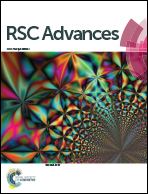Design and optimization of clotrimazole–hydroxypropyl-β-cyclodextrin bioadhesive vaginal tablets using Anacardium occidentale gum by 32 factorial design
Abstract
Clotrimazole (CTZ), a BCS class II drug, is widely employed in the treatment of vaginal candidiasis. However, due to its poor solubility, repeated administrations are required to maintain a therapeutic concentration. To increase its aqueous solubility, it was complexed with hydroxypropyl-β-cyclodextrin (HPβCD) and formulated as vaginal tablets using natural Anacardium occidentale gum in combination with Carbopol 934P. The formation of a drug–HPβCD complex was confirmed by characterization techniques, viz., scanning electron microscopy (SEM), differential scanning calorimetry (DSC), X-ray diffraction (XRD), 1H NMR and Fourier transform infrared spectroscopy (FT-IR) studies. Furthermore, 32 factorial design was employed to optimize the gum and Carbopol 934P concentrations in the development of CTZ–HPβCD vaginal tablets. In vitro analysis revealed the higher susceptibility of Candida albicans strains and significant mucoadhesion of the tablet formulation. Based on our findings, combined with Anacardium occidentale gum, the CTZ–HPβCD complex could be used for treating fungal infections, and it offers the great advantage of the higher solubility of CTZ with the therapeutic importance of higher bioavailability at the site of action. In addition, the use of natural polymers could also serve to minimize drug toxicity, which would be particularly useful for treating vaginal candidiasis safely in pregnancy.


 Please wait while we load your content...
Please wait while we load your content...